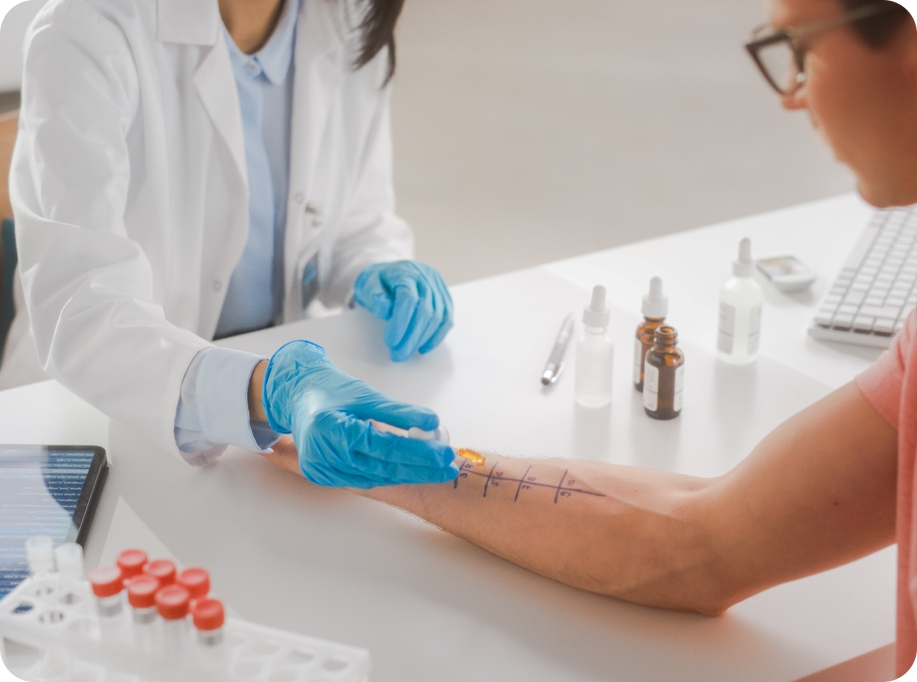
Allergy Skin Testing
Allergy skin testing is performed at Impact Medical in order to identify allergic triggers. Advantages of allergy skin testing include rapid results (within minutes) and that it is less invasive than laboratory tests.

Allergy skin testing is performed at Impact Medical in order to identify allergic triggers. Advantages of allergy skin testing include rapid results (within minutes) and that it is less invasive than laboratory tests.

Prick-Puncture: This test is performed by placing a small amount of an allergen in a liquid form on your skin. The skin is pricked so the allergen goes under the skin’s surface. The test is typically performed on the forearm or back and is ready after approximately 10 minutes. A positive test is when there is a “wheal and flare” or “swelling and redness.” This is indicative of histamine release, which occurs when one is allergic to an allergen. One must be off all antihistamines and H2 Blockers (stomach acid reducers) for at least 3 days prior to any allergy skin testing.
Intradermal Testing: This is a more in-depth allergy skin test. It is performed using a small needle and injecting a small amount of the allergen under the skin. One must be off all antihistamines and H2 Blockers (stomach acid reducers) for at least 3 days prior to any allergy skin testing.

An allergy skin test is appropriate for an individual who suspects they have allergies. Allergies to pollens, pet dander, mold, dust mites, foods, certain medications and stinging insects can all be evaluated via allergy skin testing. Allergy skin testing is often recommended for:
It’s important to consult with an allergist to determine if an allergy skin test is appropriate for your specific situation. There are some situations in which allergy skin testing is not recommended, such as Chronic Urticaria, a history of anaphylaxis to a food, or when ones skin is diffusely inflamed from Eczema or Psoriasis.
Prick-puncture and intradermal testing are performed in the office for the most common indoor and outdoor allergens.
Testing for food allergies involves prick-puncture testing, and intradermal testing if necessary.
Testing for drug allergies can include prick-puncture testing or intradermal skin testing to expose the skin to a small amount of the allergen to cause a reaction.
Skin testing exposes the skin to a small amount of each specific venom. Testing is performed via the prick puncture technique (scratch test) and then, if necessary, via the intradermal technique.
An allergy skin test is a common diagnostic procedure used to determine a person’s allergic reactions to specific substances or allergens. Here’s a step-by-step overview of what typically happens during an allergy skin test:
You’ll discuss your medical history and allergies with your allergist. They may provide instructions on medication and dietary restrictions.
Based on your history, your provider selects allergens for testing, such as pollen, dust mites, or foods.
In the skin prick test, the allergen extracts are applied to your forearm or back, and your skin is pricked to allow the allergens to enter. On the other hand, if the allergist decides to perform an intradermal skin test, this will involve the injection of a small amount of the suspected allergen under the surface of the skin
You’ll wait for 10-15 minutes without scratching or touching the tested area.
The provider checks for raised bumps (wheals) and redness, indicating allergic reactions. Your healthcare provider discusses which allergens triggered reactions and their severity, guiding your allergy management plan.
Note: Allergy skin tests are generally safe and well-tolerated but there is a minimal risk of experiencing an allergic reaction during the test. Immediate medical attention will be provided if needed.
Skin tests for allergies are typically performed on the forearm or back. Your allergist will clean the area to be tested and then apply a small amount of each allergen extract onto the skin. They may use a specialized device to prick the skin (called a skin prick test or allergy scratch test) or inject a tiny amount of allergen under the skin (called an intradermal test).
Reading allergy skin test results involves observing the appearance and size of skin reactions to specific allergens. These reactions usually manifest as raised, red bumps surrounded by redness on the skin. A positive reaction indicates sensitivity to the allergen, while a negative reaction suggests no sensitivity. Our allergists are ready to assist you in interpreting your allergy skin test results today!
The duration of skin testing can vary depending on the number of allergens being tested and the specific testing method used, but usually, a skin prick test or allergy scratch test takes about 10-15 minutes. Similar duration for intradermal tests.
Skin testing is generally well-tolerated and is not typically painful. Patients may experience mild discomfort or a slight stinging sensation during the skin prick test or intradermal testing, but it is usually brief and tolerable. Our providers are here to provide the best experience when talking about allergy tests.
Overall, when performed and interpreted correctly, allergy skin tests are valuable tools for diagnosing allergies and choosing treatment strategies. However, they should always involve a comprehensive clinical evaluation for the most accurate diagnosis and management of allergic conditions.
Yes, children can undergo skin testing for allergies. However, the testing methods and allergens used may be tailored to their age and developmental stage. You can consult with an allergist at Impact Medical to determine the most appropriate testing approach for your child.
Yes. After performing the skin tests and interpreting the results, the allergists at Impact Medical will discuss the findings with you and develop a personalized treatment plan if needed.
The cost of an allergy skin test can vary depending on several factors such as the type of test used, the number of allergens tested. The cost of an allergy skin test without insurance coverage typically ranges from $100 to $300 or more. To know more about insurance coverage and skin allergy test costs, contact us today!
